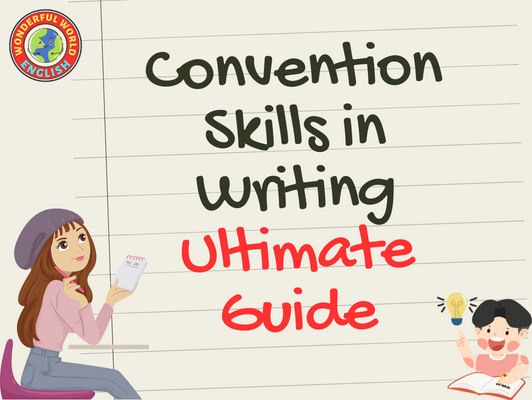Contents
Toggle
Meet David De’ Ath, founder, editor, and writer at Wonderful World English. With his extensive background as an English teacher, David provides valuable insights and practical tips on ESL for students and teachers alike.
For anyone looking to navigate the world of written communication, it’s essential to grasp the art of writing conventions.
These skills are more than a set of important rules; they’re the pillars that support clear, impactful, and polished writing.
Imagine you’re composing an important email, weaving a story for your next novel, or putting together a crucial business report.
In these and countless other scenarios, a solid understanding and adept application of writing conventions can dramatically elevate the clarity and effectiveness of your written message.
Master the art of writing by refining key skills: grammar for clarity, precise spelling, effective punctuation, strategic capitalization, structured paragraphing, consistent style, and clear, concise expression. These elements elevate your writing and ensure professional, engaging communication.
I am an experienced English teacher with a background in journalism, and I can attest to the importance of effective writing skills in a wide array of fields.
Whether you’re writing creatively, academically, or socially, you’re in the right place.
This guide will explore the fundamentals of convention skills in writing, their importance, and how you can apply them to take your writing to the next level.
Let’s embark on a journey to uncover the essential writing convention skills that every writer, novice or expert, should master.

Conventions Skills in Writing
Writing conventions are the building blocks of effective communication.
As we dive into these essential elements, our first focus is on grammar.
It’s the foundation of clear writing, helping to ensure that your message is understood exactly as you intend.
Let’s explore how grammar can enhance your writing’s clarity and effectiveness:
1. Grammar
Firstly, think of grammar as the essential guide in your writing arsenal.
Grammar is a fundamental set of rules and the foundation that holds your writing together.
Proper grammar encompasses everything from the accurate construction of sentences to the appropriate use of verb tenses and the agreement between nouns and pronouns.
When you master the nuances of grammar, you ensure that your writing conveys your thoughts just as you intended, minimizing misunderstandings.
Imagine grammar as a friendly guide, leading your readers effortlessly through the landscape of your ideas.
Grammar can be quite tricky for some people to master, especially English as a Second Language (ESL) students who speak a native language with different grammar rules to English.
Fortunately, there are some excellent tools available to help anyone improve their grasp of English grammar.
For a list of our most recommended apps to help master grammar, click the link below!
Related Article: Which is the Best App for Learning English Grammar? – Top 10

2. Spelling
In the art of writing, correct spelling is an absolute must.
It goes far beyond just sidestepping typos; it’s about crafting a piece that radiates professionalism and attention to detail.
A piece of writing that has bad spelling is instantly dismissible.
Misspelled words are more than mere oversights; they can jolt your reader out of the narrative and overshadow the essence of your message.
While spell-check tools are helpful allies, they can’t replace the human touch.
A sharp eye for detail is your best defense against these small yet significant errors.
When you get spelling right, it subtly enhances the quality of your work, leaving a lasting impression of excellence and care.
Spelling, as well as other fundamental aspects of writing, will be improved by reading more.
Sometimes, reading big words in English can be difficult, especially for ESL learners.
If a helpful guide on how big words can be read more easily will bring you value, the link below is for you!
Related Article: How to Read Big Words in English – The Guide
3. Punctuation
Punctuation marks are akin to the conductors of an orchestra in the symphony of writing.
They don’t just punctuate and add clarity; they breathe life into your sentences, orchestrating the rhythm and tone and enhancing them with emotion and emphasis.
Consider the versatile comma, pausing the reader just enough to add clarity, or the exclamation point, injecting energy and passion into the writer’s words.
Each punctuation mark plays a distinct role, transforming a string of words into a compelling, coherent narrative.
By mastering punctuation, you unlock the potential to make your writing understood, felt, and experienced.
The most effective writers know when and where to put punctuation to connect with the reader best.
This applies to all areas of writing, including titles.
For a guide on how to properly punctuate titles, from books to articles, check out the link below!
Related Article: How to Punctuate Titles – Ultimate Guide with Examples

4. Capitalization
Much like punctuation, capitalization in writing is far more than just for cosmetics; it’s essential for adding clarity to a body of text.
Capitalizing the first letter of a sentence signals a fresh start, guiding your reader smoothly from one thought to the next.
Regarding proper nouns, capitalization elevates their significance, showing due respect to people, places, and titles.
This seemingly small detail plays a significant role in setting the tone and enhancing the readability of your writing.
It’s not just about making words stand out; it’s about using capital letters strategically to bring structure and emphasis to your message.
Make sure to understand when it is appropriate to capitalize a letter to ensure authority and trustworthiness to your work.
5. Paragraphing
Think of paragraphing as the art of organizing your thoughts into a structured, flowing narrative.
Each paragraph serves as a distinct building block, housing a single, focused idea embellished with supporting details.
This methodical arrangement breaks down complex information into manageable chunks, making a body of writing more approachable and digestible for your readers.
A well-crafted paragraph holds the reader’s attention and guides them through your narrative, creating a seamless reading experience.
By mastering the skill of paragraphing, you ensure that your writing is not just read but also understood and appreciated in its full context.
To paragraph properly, follow these guidelines:
- One Idea Per Paragraph: Start a new paragraph for each new idea or topic. This helps to separate and organize your thoughts clearly.
- Topic Sentence: Begin each paragraph with a topic sentence that introduces the paragraph’s main idea.
- Supporting Sentences: Follow the topic sentence with supporting sentences that elaborate on the idea, providing details, explanations, or examples.
- Cohesive Flow: Ensure your paragraphs flow logically. Each paragraph should connect to the next, creating a cohesive narrative or argument.
- Length: Keep paragraphs concise. Aim for a few sentences per paragraph, but this can vary depending on the context and medium.
- Concluding Sentence: Optionally, end with a concluding sentence that summarizes the main point or transitions to the next idea.
By adhering to these guidelines, your writing will be clearer, more organized, and easier for readers to follow.

6. Consistency
Consistency is the secret sauce that binds all elements of your writing into a cohesive whole.
It means sticking to a particular style or tone and creating a harmonious reading experience.
When your writing maintains a consistent style, tone, and formatting, it becomes a smooth, uninterrupted journey for your readers.
This uniformity is crucial in professional writing, as it eliminates distractions caused by sudden shifts or inconsistencies.
By ensuring consistency, you keep your audience’s attention riveted on your message, allowing your words to make a more profound impact.
We suggest reading as much as you can and focusing on how the writer conveys their message.
Think about their style and tone, and mold your style around it, be sure to add your own unique flavor and personality too!
7. Clarity and Conciseness
And finally, in today’s information-rich world, conveying ideas with clarity and conciseness is very valuable.
The key lies in presenting your thoughts simply and directly, stripping away any unnecessary complexity.
This approach makes reading much easier to understand and digest and transforms it into a pleasure to read.
Clear and concise writing respects the reader’s time and attention, delivering your message without excess or ambiguity.
By mastering the art of being precise and to the point, you ensure that your writing is consumed, appreciated, and remembered.
Here are some tips to help you write more concisely:
- Get to the Point: Start with your main idea or argument. Avoid long introductions.
- Eliminate Redundancies: Remove words or phrases that repeat the same idea. For example, instead of saying “each and every,” just say “each.”
- Use Simple Words: Choose simpler words over complex ones when they convey the same meaning.
- Shorten Your Sentences: Break long sentences into shorter, clearer ones. Aim for an average of 15-20 words per sentence.
- Avoid Filler Words: Cut out unnecessary words like “very,” “just,” “really,” and “quite,” which often add little to your message.
- Use Active Voice: Active voice tends to be more direct and concise than passive voice. For example, “The team completed the project” (active) is more concise than “The project was completed by the team” (passive).
- Focus on Strong Verbs: Strong verbs convey more information and can often replace a verb-adverb combination. For example, “run quickly” can be replaced with “sprint.”
- Prune Unnecessary Details: Only include details that are essential to your main point.
- Edit Ruthlessly: After writing, go back and edit your work. Look specifically for words or sentences that can be removed without changing the message.
By applying these techniques, you’ll be able to communicate more effectively, making your writing clearer and more engaging for your readers.
For a complete guide that solely focuses on sharpening all-around writing skills, the link below has it all!
Related Article: How to Sharpen Writing Skills – Full Guide

Conclusion
Mastering these writing conventions is a sure way to take anyone’s writing to the next level.
Good writing is a process that demands meticulous attention to detail, relentless practice, and an ever-present eagerness to absorb new knowledge.
As you sharpen these essential skills, your writing begins to transform, evolving from merely good to truly exceptional.
This journey ensures that your ideas are not just communicated but resonate with clarity and professionalism.
In the intricate craft of writing, every detail plays an essential role.
Embracing these conventions is not just about following rules; it’s about nurturing your writing to bloom to its fullest potential.
So, continue to hone these skills and witness the remarkable growth in your writing endeavors.
We hope you find value in this guide; you can contact us if you are in need of any assistance as a student or a teacher.
Have a wonderful day!
Image Attribution: All images licensed via canva.com





